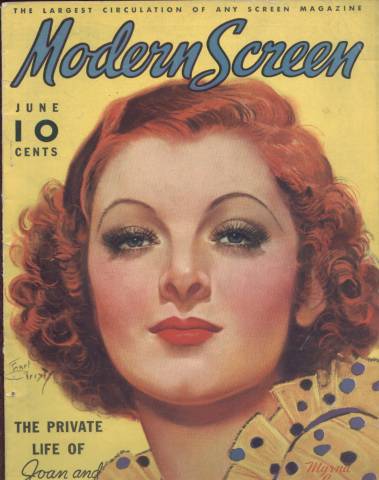The First Movie Magazines Debut: Motion Picture Story and Photoplay
Fans of the early flickers eat up information about their favorite stars in the early movie magazines. Today collectors pay a premium for 1910’s movie magazines even if they are so beat up that they’re missing their covers!
Motion Picture Story debuted in February 1911 as the first consumer based movie periodical. Prior to Motion Picture Story there had just been trade journals such as Moving Picture World that were intended for the film industry, not fans.
Before 1910 the studios did not credit or release the names of the players in their pictures. Fans hounded until they did, and once done those fans wanted even more information about their favorite actors and actresses. Originally in the mid-1910’s the fan magazines responded by telling the fans that nearly every star was in real life the same as the persona they presented on the screen. Nobody within the industry wanted to break the popular image, for fear of backlash from the paying customers.
Photoplay Magazine
Photoplay first appeared in 1912, but was not initially successful. However, when James Quirk took over editorial duties in 1914 he implemented changes that would make Photoplay the top film magazine, one which by 1922 would boast a circulation of over two million.
Quirk brought in professional writers, he pushed the idea that film transcended entertainment and was actually art, and in a move that coincided with the constant discouragement offered to young people, especially women, trying to break into films, he banned ads from acting schools.
Instead of engaging his readers with false hope, Quirk’s Photoplay instead warned them to keep away from the Hollywood gates and encouraged female readers to emulate their favorites through the fashion and glamour presented on the pages of his publication. Glamour advertising accompanied the editorial content of Photoplay and Quirk encouraged readers to read the ads as carefully as the stories.
Throughout the 1920’s the pages of Photoplay gave readers what they had craved from the start: information about the private lives of movie stars. Much of this information was glamorous fiction sprinkled with facts leading to a blur between fact and fiction which in some cases persists to this day. Readers continued to absorb the information presented to them while at the same time more sophisticated readers realized that the articles were just another form of entertainment.
In the 1930’s articles would grow more gossipy as writers such as Hedda Hopper, Adela Rogers St. John, and Louella Parsons, transformed themselves into powerful personalities through their columns.
 The early covers of the old movie magazines are works of art, vivid color illustrations by talents such as F. Earl Christy and Marland Stone. The Myrna Loy cover shown on this page is an example of Christy’s work. It appeared on the June 1936 cover of Modern Screen, another popular publication that was issued into the 1970’s. From this example alone you can see why older movie magazines are such demand items.
The early covers of the old movie magazines are works of art, vivid color illustrations by talents such as F. Earl Christy and Marland Stone. The Myrna Loy cover shown on this page is an example of Christy’s work. It appeared on the June 1936 cover of Modern Screen, another popular publication that was issued into the 1970’s. From this example alone you can see why older movie magazines are such demand items.
An excellent article by Dr. Quint Randle titled in part “the Effects of New Mass Media on Magazine Publishing” notes that “Between 1911 and 1938 alone, 60 consumer magazines … were founded that address the subject of films, cinema, movie stars, and production.” Randle mentions a few titles along with their first year of publication, which is important for our purposes here–besides Motion Picture Story in 1911 and Photoplay soon after, he notes Picture Play (1915), Screen Play (1925), Screen Romances (1929), Movie Life (1937) and Movieland (1942). We can also add to this list Modern Screen which I believe debuted in 1928 and Movie Story in the early 1930’s.
Movie Magazines Worldwide
Movie magazines weren’t just an American obsession. Magazines cropped up from around the world, some notable titles being the Scandanavian Filmjournalen, Mon Cine from France, Imagem from Germany, Cinefilo from Portugal, Lecturas from Spain, Cine-Mundial and Cinelandia out of Cuba, and of course, English-language Picturegoer, Picture Show and others from Great Britain. Of these Lecturas and the Cuban magazines were higher quality bound publications, while the others were all issued on newsprint and are quite fragile when you come across them today. Filmjournalen, Mon Cine, and Imagem are impressive in their own rights as they were oversized publications with quality photographic covers. The Cuban magazines often had colorful high-quality illustrations as covers similar to their American neighbors to the north.
By the late 1930’s into the early 1940’s the cover art for film publications shifted from these lavish illustrations to photography. While not as desirable as the earlier covers, the photography is always of the highest quality and the publications through the 1940’s are also on many collector’s want lists.
The movie magazines still hung around into the 1950’s and beyond, but America’s obsession with gossip led to trashier publications such as Inside Story and On the QT, which left the films behind in favor of sensationalized stories about the personal lives of movie stars and celebrities. The national obsession soon thereafter shifted to Rock & Roll’s early legends such as Elvis Presley and the Beatles and movie magazines began to be squeezed out by the emergence of teen magazines covering these and other youth idols.
Source:
- Barbas, Samantha. Movie Crazy: Fans, Stars, and the Cult of Celebrity
. New York: Palgrave Macmillan, 2001.